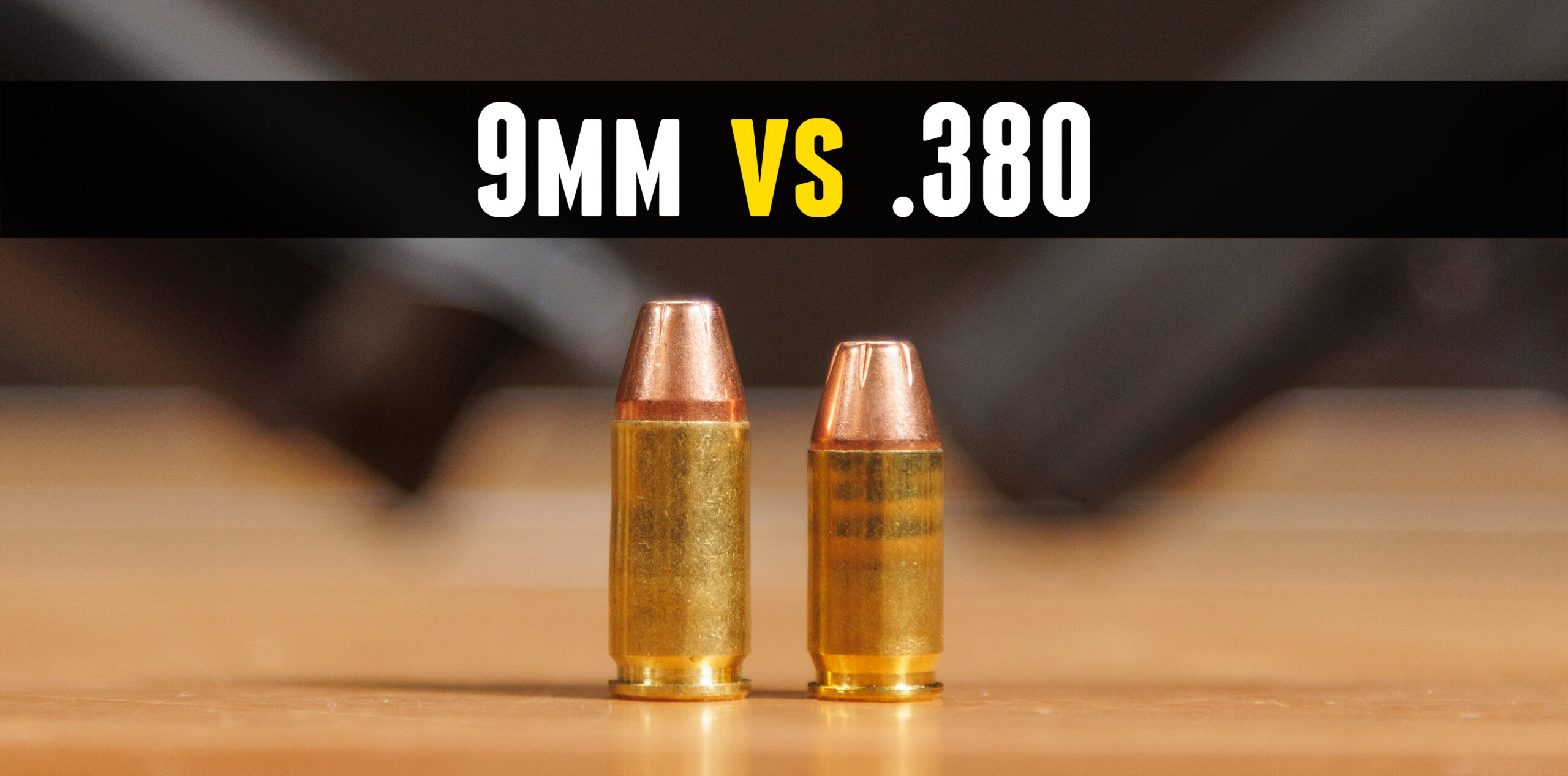A number of companies make compact carry pistols in both 9mm and .380 ACP, marketing .380 to women and those who desire less recoil. Besides size, what really are the differences between these two cartridges?
Disclaimer
Ultimate Reloader LLC / Making with Metal Disclaimer: (by reading this article and/or watching video content you accept these terms). The content on this website (including videos, articles, ammunition reloading data, technical articles, gunsmithing and other information) is for demonstration purposes only. Do not attempt any of the processes or procedures shown or described on this website. All gunsmithing procedures should be carried out by a qualified and licensed gunsmith at their own risk. Do not attempt to repair or modify any firearms based on information on this website. Ultimate Reloader, LLC and Making With Metal can not be held liable for property or personal damage due to viewers/readers of this website performing activities, procedures, techniques, or practices described in whole or part on this website. By accepting these terms, you agree that you alone are solely responsible for your own safety and property as it pertains to activities, procedures, techniques, or practices described in whole or part on this website.
Semi Automatic Pistols for Self-Defense: A Brief History
Many people don’t realize how long semi-automatic pistols, and many of the cartridges for them, have been around and in use. The introduction of smokeless powder spurred the development of several semi-automatic pistols in the 1880s and 1890s, mostly in Germany and Austria. Perhaps the most successful of these was the Mauser 1896—often nicknamed the “Broomhandle Mauser ” for its appearance. More than a million were made over its 40 years of production.
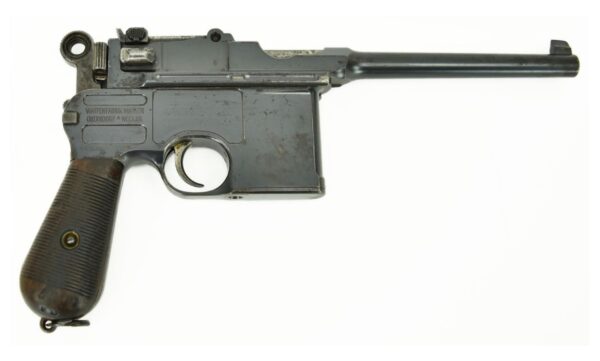
By 1902, the German Luger pistol and the 9mm Parabellum cartridge had arrived! (Yes, the 9mm Luger is older than the .45 ACP…)
Here in the USA, John Moses Browning developed the Colt Model 1900 in .38 ACP, and eventually the more powerful .380 ACP. The U.S. Army wanted a more powerful pistol to replace the older revolvers they were using and adopted the Colt .45 ACP in 1911. It’s interesting that the 9mm Parabellum and .45 ACP, two very popular semi-automatic cartridges, were introduced well over 100 years ago. They are still going strong, better than ever!
Semi-Automatics for Self-Defense: Considerations
Semi-automatic pistols can be excellent for self-defense. They are easily capable of rapid fire and are very quick to reload. The physical size of the pistol is of extreme importance as they vary considerably in size and weight. A smaller pistol is easier to conceal, but can be difficult to shoot well. The short sight radius, small grip, and lack of weight all conspire against accurate shooting.
A full-size semi-automatic can be difficult to conceal, particularly in warmer months, but it is possible if care is taken to dress accordingly. Much of this is due to the “flat” design of semi-automatics. Bigger guns typically offer a larger, more comfortable grip; a longer sight radius; more weight to offset the recoil; and superior sights. All that adds up to a gun that is easier to shoot well—as long as the user can handle the power of the cartridge. If the handgun isn’t going to be concealed (ex. nightstand gun), then size is less important.

My personal semi-automatics range in size from a tiny 3.1” barreled Kahr 9mm to a full-size, all steel 5” barreled Kimber 1911. I have often carried the 1911 concealed under a vest or a jacket, but the compact 9mm is much easier to conceal. I recently had the opportunity to shoot Gavin’s new CANiK METE MC9 carry pistol. We are limited to 10-round magazines here in Washington state, but it traditionally comes with both 12 and 15 round magazines in a complete kit with holster. This concealed carry pistol is approximately the same size as my Kahr, but with a 3.18” barrel. It was very easy to shoot and I look forward to doing more work with it.
All things considered, the best “stopping power” is produced by excellent shot placement. Good hits from a modestly powerful handgun are much more effective than misses or poor hits from a very powerful handgun.
History of the 9mm Luger and .380 ACP
The 9mm Luger was introduced in Germany in 1902 and has been known by many names: 9mm Luger, 9mm Parabellum, 9×19, and most simply— 9mm.. By whatever name you know it, it has become the most popular centerfire pistol cartridge for a number of good reasons. Americans largely ignored it, favoring the .45 ACP, until the military adopted the Beretta 92 in the 1980s and law enforcement followed suit with the GLOCK. I personally observed a significant change as my department traded in their revolvers for semi-automatic 9mm. Throughout the 1990s, subcompact 9mm for concealed carry also rose in popularity.
In North America, by 1908, Browning had developed the .380 ACP, which was actually larger and more powerful than the popular .32 semi-auto cartridge of the time. This one is often referred to just as “.380” and sometimes as the 9mm Kurz (short). Despite that last moniker, it is not just a shortened 9mm case. Most .380 pistols are compact with a blowback design, known for their light recoil.
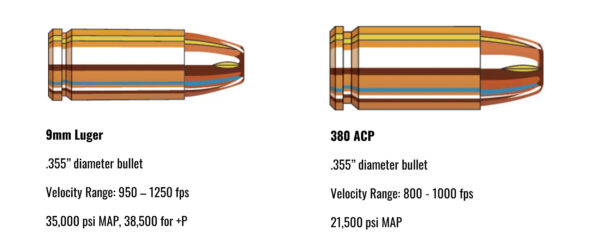
Although outwardly similar, the 9mm and the .380 ACP are quite different cartridges. The 80 is not simply a shortened 9mm case, but its own design. Both utilize .355” diameter bullets. The .380 ACP typically uses a lighter bullet of 85 to 100 grains compared to the 115 to 147 grain bullets used in 9mm. The .380 ACP also operates at considerably lower pressure (21,500 psi MAP).
In contrast, the 9mm operates at 35,000 psi Maximum Average Pressure in standard loads and up to 38,500 psi in the +P loads. This produces very good velocity for such a small case.
Ballistics
The 9mm Luger and the .380 ACP were both intended for self-defense. 9mm only grew in popularity as a carry round as smaller, more concealable pistols for it were reproduced. 9mm +P ammunition offers nearly double the energy of a .380 ACP.

Common Self-Defense 9mm +P and .380 ACP Ammo Types
Both 9mm +P ammo and standard 9mm ammunition are widely available. Most 9mm is available in value-packed quantities of 500 or 1000 or more cartridges of FMJ range ammunition. Hollow point self defense rounds are more expensive, but very commonly found.
The .380 ACP is also readily available, but I’ve seldom seen it discounted, and the overall selection is not as large as the 9mm.

Costs
Ammunition for 9mm and .380 ACP is less expensive than for many of the other self-defense handgun cartridges we’ve looked at: .45 ACP, 10mm, .40 S&W, .357 SIG, .357 Magnum and .38 Special. Factory self-defense 9mm +P and .380 ACP ammunition both fall between $0.88 and $1.44 per round. Handloaders can build high-quality ammunition using good expanding bullets for considerably less. Using Hornady XTP bullets and new brass, I was able to load 9mm Luger for about $0.67 per round and .380 ACP for $0.56 per round. Reusing the brass cases cuts the cost to approximately $0.35 to $0.40 per round. For even more affordable practice ammunition, I use plated, cast or full metal jacketed bullets.
About the Loading Setups
I used two different presses: one for 9mm and another for .380 ACP. For the 9mm, I used a Lyman All-American 8-station turret press and Lyman carbide dies.

I’ve loaded a lot of ammunition, both rifle and handgun, on this press and it continues to perform flawlessly. My four-die set included a taper crimp die. I usually prefer to seat the bullet and crimp in separate steps.
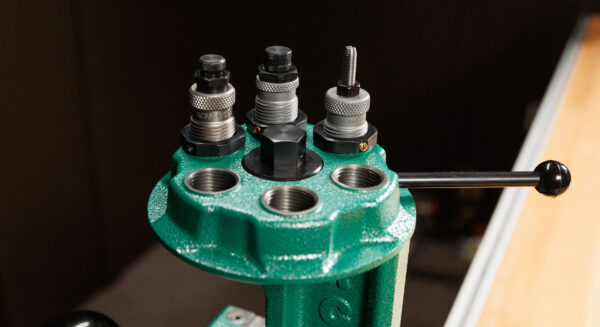
RCBS builds a quality, compact turret press which I used to load all the .380 ACP ammunition for this project. It is comfortable and easy to use. I prefer to prime off-press, so removed the priming system from the press for this project. I paired this with a three-die set of RCBS carbide dies. I had no problem adjusting the seating die to produce a good taper crimp.
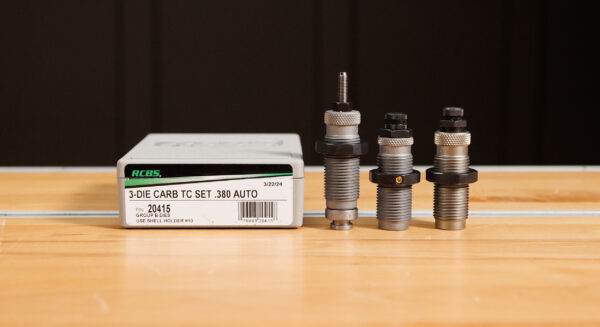
About the Pistols
Since the 9mm is so popular and has existed for so long, it has been chambered in a wide variety of pistols. I chose several different ones to demonstrate just how different they can be.
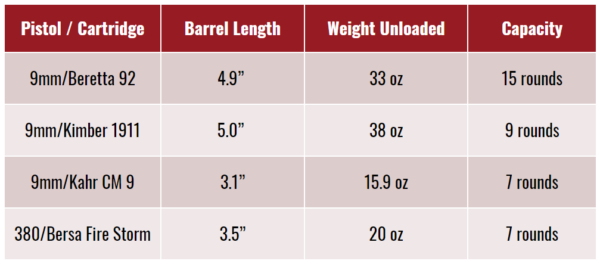
Beretta 92 – The U.S. military adopted the Beretta 92 and the 9mm cartridge in the 1980s as the standard handgun. As a result, this gun became well known around the world and remains an iconic choice for 9mm handgunners.
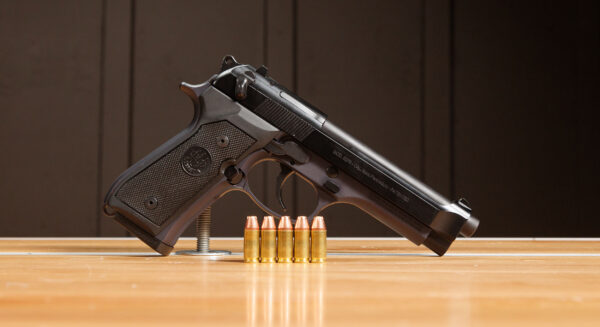
Kimber 1911 – While 1911’s are most associated with .45 ACP, they have been available in 9mm since the 1950’s. I knew one Marine Corps Sergeant Major who brought his personal Colt 9mm 1911 on deployment as he dearly loved the 1911 platform but knew that 9mm ammo was going to be much more available than .45 ACP ammo. My Kimber 9mm 1911 has a 5” barrel and a steel frame. It’s the heaviest 9mm in this article.

Kahr CM9 – THe Kahr CM9 is an American-made single stack compact pistol well-suited for concealed carry. There weren’t very many compact 9mm’s available when the first Kahr 9mm compact pistol was introduced and it continues to be a fine performer. Nowadays there are many different compact 9mm pistols available and shooters have a wide selection from which to choose. The Kahr has an interesting and useful double action only trigger and a single stack magazine. It, like other compact single stack 9mm pistols, conceals well.
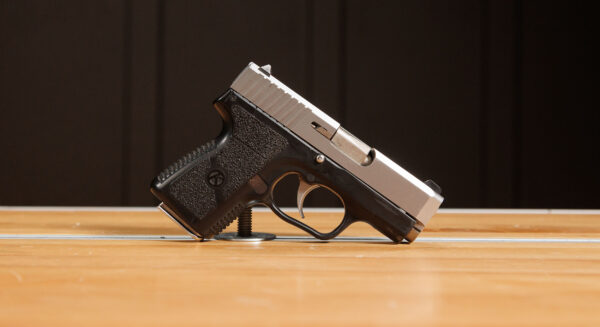
Bersa Firestorm – I only have one pistol chambered for .380 ACP, a Bersa Firestorm. The Firestorm is an inexpensive pistol, but ergonomically excellent. It’s reliable, accurate and comfortable to shoot. Made in Argentina, the quality is better than expected for the price range.

About the Loads
Remember that self-defense handloads are a controversial subject. Some argue that handloads put an individual at greater risk in both criminal and civil trials after a shooting. (Even in a justified shooting, a civil suit is likely.) Others say the use of handloads poses no legal risks. It pays to research the subject and make your own decision. I prefer to use factory loads for my carry guns, in part because of the low-flash additives to the powder used by many manufacturers. Commercial self-defense ammo is held to high standards, but there can be failures even with ostensibly high-quality commercial ammunition. Please work up carefully to the level where you are comfortable and safe and do not exceed published load data.
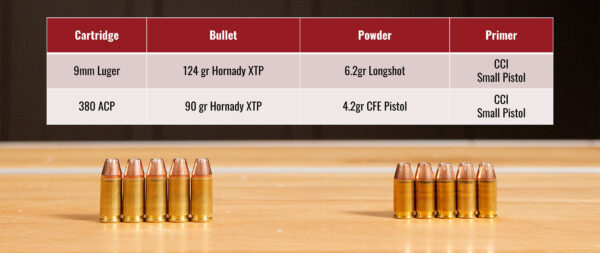
Hornady’s XTP bullet became available over 30 years ago and has earned a great reputation as a self-defense bullet and also for hunting medium game. I chose to use XTP bullets for this comparison: a 124 grain XTP for the 9mm and a 90 grain XTP for the .380 ACP.
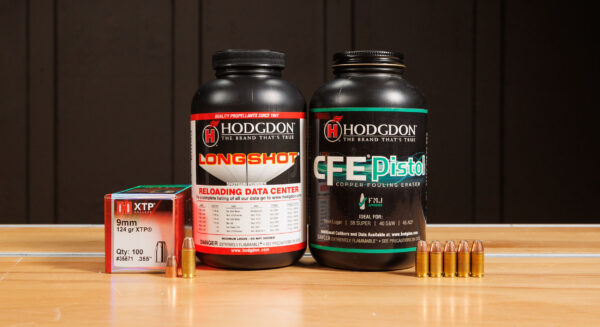
I always choose more power when it comes to self-defense cartridges and opted to load 9mm +P instead of the standard load. The 9mm +P has long been desired by military, law enforcement and private citizens. I paired the 124 grain Hornady XTP with Longshot powder. Longshot is an easy powder to like. It produces good velocity and accuracy, seems to be quite clean-burning, and it flows nicely through a mechanical powder measure, making it an excellent choice for reloading on a progressive press.
9mm +P ammunition is limited to 38,500 psi maximum average pressure; standard 9mm is limited to 35,000 psi. Hodgdon’s Online Reloading Data Center listed a starting load of 4.8 grains of Longshot with a maximum load of 6.2 grains. (Hodgdon’s Annual Manual also has lots of information.)

Something I found quite interesting is that Hodgdon showed a 1,051 fps velocity with a 4.8 grain charge at 26,200 PSI and 1,209 fps with a 6.2 grain charge at 32,900. Both of these are high velocities with pressures below the standard 9mm limit! Be sure to watch your overall cartridge length while loading 9mm. Shortening 9mm ammunition can send pressures soaring.
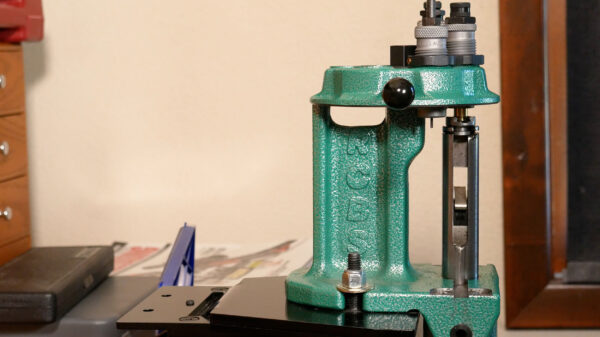
The diminutive .380 ACP case is limited not only by case capacity, but also by the far lower pressure limits. Hodgdon’s Online Reloading Data Center specified a starting load of 3.7 grains and maximum load of 4.2 grains of CFE Pistol with a 90 grain XTP.

This versatile powder works well in a variety of different handgun cartridges. Hodgdon’s data indicated that it would offer good performance with the small .380 ACP case. Like Longshot, it flows nicely through a powder measure, making it very useful for progressive reloading presses.
Results
I was pleased to see a full 1200 fps with the 124 grain XTP bullet and a 5” barrel. That’s faster than my 2.5” .357 Magnum Model 19 revolver produced with a 125 grain bullet!
The shorter-barreled 9mm Kahr saw a loss of about 130 fps. This is a reasonable trade-off for gaining concealability.
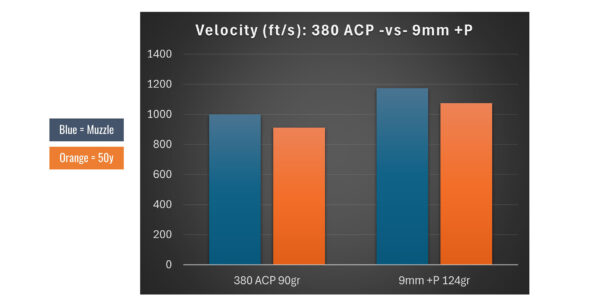
That 1,200 fps figure with the 124 gr bullet is significant. It’s about 200 fps slower than the .357 SIG with the same bullet and a 125 grain .357 Magnum load from a 6” revolver. The little .380 managed only 830 fps with a maximum load from Hodgdon. That’s not a lot of power, but it was a very easy load to shoot. Excellent results were obtained with both handloads.

Shooting Impressions
Most of these produced modest recoil compared to the more powerful defensive handguns we’ve shot recently.
Kahr CM-9
The worst offender in the recoil department was the little Kahr CM9 with full power 9mm handloads. Maintaining a good grip on this firearm is a must. The Kahr is easier to grip and control with the extended magazine in place. It has a long, smooth double-action only trigger pull reminiscent of a double-action revolver.
Beretta 92
The 33 ounce Beretta 92 was much easier to shoot. This raises a simple, yet important point— if all else is equal —cartridge, bullet, and powder charge— then the larger pistol will be easier to control, nicer to shoot, recoil less, help the shooter recover more rapidly between shots and stay on target better. There are a lot of advantages to choosing a full-size pistol. The only real drawback is they are more difficult to conceal.

I was prepared to not like the 9mm Beretta when the Marine Corps replaced my .45 ACP 1911 with it in the 1980s . Firing only one magazine convinced me otherwise. It was accurate, dependable, and easy to shoot!
The Beretta features a classic, double-action trigger pull for the first shot. The rest require only a short, crisp single-action trigger pull. This can be disconcerting for people new to shooting a traditional double-action semi-automatic pistol, but is a skill that can be learned. After shooting the 9mm Beretta a bit, the trigger became second nature.
Kimber 1911
I’m always surprised by the lack of recoil when I switch from my .45 1911 to this 9mm 1911. It is even easier to shoot than the Beretta 92! It’s heavier and the slim grip fits my hand better. Also, I have to admit that I’m a bit of a 1911 addict.

The 1911 has a famous short, crisp trigger pull, very positive thumb safety, and traditional grip safety. The simple all-black sights are good, but I suspect that I’ll replace the front sight with something that provides more contrast with a black painted target. The rear is adjustable for windage and elevation. Fixed sight 9mm 1911’s are also available.
Bersa Firestorm
If you haven’t shot a .380 before, you may be pleasantly surprised with the lack of recoil and fairly mild report. Though an inexpensively-priced pistol, the Bersa Firestorm features an ergonomic design with very comfortable grips. Between the mild recoil and comfortable grip, it was very easy to keep the well-designed sights on target and make repeat hits.

Head-to-Head
There is no doubt about it: the 9mm has higher velocity, produces more power, and hits harder. Recoil is very easy to manage in full-size pistols. Only in the compact Kahr, particularly when using the short magazine, was the 9mm uncomfortable to handle. The 9mm has another significant advantage — both ammunition and components are readily available. FMJ range ammo is inexpensive compared to other larger cartridges.
The .380 ACP was delightfully easy to shoot in the compact Bersa Firestorm, it just simply doesn’t offer as much power as the 9mm. Ammo and components are somewhat less available than the 9mm, but it’s a popular enough cartridge that it’s not a big chore to feed it with either factory ammo or to assemble handloads for it.
Conclusion

I personally favor the 9mm for its velocity, power, and general availability. It’s “enough” cartridge for a combat or self-defense role without being as difficult to shoot as harder-recoiling options.
Though much less powerful, the .380 ACP though continues to be a viable self-defense cartridge with exceptionally good manners. It really treats the shooter well with its light recoil.
Get the Gear
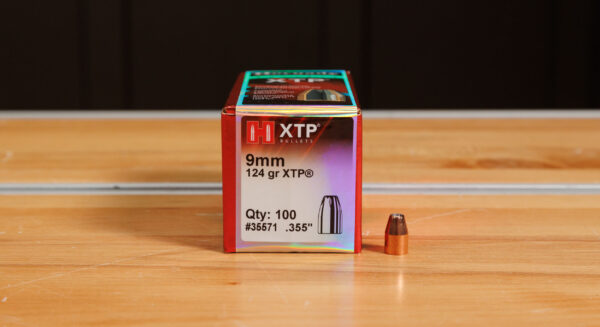
Hornady 9mm .355 Diameter 124 Grain Hollow Point XTP at Midsouth Shooters Supply
Hornady 9mm .355 Diameter 90 Grain Hollow Point XTP at Midsouth Shooters Supply
Hodgdon Longshot Smokeless Powder at Midsouth Shooters Supply
Hodgdon CFE Pistol Smokeless Powder at Midsouth Shooters Supply
CCI #500 Small Pistol Primers at Midsouth Shooters Supply
Hornady 9mm Unprimed Pistol Brass at Midsouth Shooters Supply
Starline .380 Auto Unprimed Pistol Brass at Midsouth Shooters Supply
Hodgdon Annual Manual at Midsouth Shooters Supply
RCBS .380 ACP Carbide Taper Crimp 3 Die Set at Midsouth Shooters Supply
Lyman 9mm Luger Carbide Full Length 4 Die Set at Midsouth Shooters Supply
RCBS Turret Press at Midsouth Shooters Supply
Lyman All-American 8-Turret Press at Midsouth Shooters Supply
Garmin Xero C1 Pro at Creedmoor Sports and Midsouth Shooters Supply
Don’t miss out on Ultimate Reloader updates, make sure you’re subscribed!
Thanks,
Guy Miner
